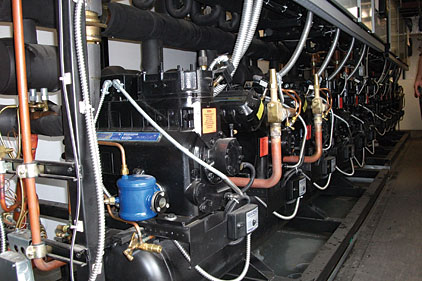
|
| Familiar HFC refrigeration systems such as this one at a supermarket in Arizona could be around for a while. There appears to be little happening regarding HFC phasedown. |
There is currently “no draft language published” in Europe regarding f-gas regulations, according to Alain Compingt, research and development director for Heatcraft Worldwide Refrigeration — Europe. He told an audience of supermarket engineers at the Food Marketing Institute’s Energy & Store Development Conference that there is a focus on various carbon levies in Europe to make use of such f-gasses as HFCs more costly.
“You can expect tightened requirements and potential tax or other means to bridging the capital cost gap between traditional and natural refrigerant technologies,” Compingt noted.
HFC-134a Regains Foothold
At the same time, a first wave effort to phase out an HFC refrigerant in Europe seems to be experiencing a pushback. The website Green Car Congress reported on Sept. 27 that the automobile manufacturer Daimler is going to continue to use HFC-134a in its automobile air conditioners and not convert to HFO-1234yf for the time being. The article said the manufacturer was concerned about the HFO being “dynamically dispersed at high pressure near hot components of a test vehicle’s exhaust system.”
The article quoted Daimler as saying, “The tried-and-tested R-134a refrigerant is the technical alternative. In such a globalized world, there can really only be a single refrigerant which all vehicle manufacturers use. We will involve ourselves extensively in the international selection process. Together with our technology partners, we will be intensively looking at a long-term solution.”
Daimler did acknowledge regulatory mandates to phase out the use of R-134a in auto air conditioning in Europe, but Daimler spokesperson Matthias Brock said that the company “expects that it and the authorities will come to a mutual agreement.”
Following the Daimler announcement, both Honeywell and DuPont, who jointly developed 1234yf, issued statements attesting to the safety of the refrigerant in automotive air conditioning.
It should be mentioned that HFOs other than 1234yf are continuing to be tested for stationary applications.
In terms of stationary equipment in Europe, Compingt said, “There is an increasing trend toward R-134 in terms of competitive energy usage, reduced environmental impact, competitive maintenance costs, and reduced legislative/tax liability.” He noted, “R-134a/CO2 cascade and R-134a-glycol/CO2 cascade are particularly popular.”
HFCs Stateside
What is clear is that any actions phasing down HFCs would come first in Europe. Currently, it is uncertain if and when that action could cross the Atlantic and reach North America.
“Europe typically does not consider economic impact as heavily in environmental legislation. Economic impact is typically a major consideration in the U.S. That tends to drive a slower, more deliberate, and less radical approach in the U.S.,” said Jim Knudsen, global segment leader of food retail and foodservice for Heatcraft Worldwide Refrigeration.
His thoughts were echoed by Ron Elving, National Public Radio’s senior Washington editor. Speaking to the FMI conference several months before the November 2012 election, Elving said “a sluggish recovery, escalating debt, and global economic unease” will affect any decisions made by any Congress, no matter the makeup of the Senate or House.
And that was interpreted by a number of conference attendees as a sign that action against HFCs will not gain much momentum because of economic reasons.
A further roadblock could even come on the environmental front. Elving correctly predicted that Democrats would not win enough seats to win control of the House, which means Congress continues to be divided. As with the economic aspect, those at FMI who closely follow congressional action did not see unanimity over environmental issues, especially with the economics factored in.
Alternatives Still on Table
At the same time, both Compingt and Knudsen said European and U.S. agencies are exploring ways to use non f-gasses in wider applications.
Compingt said one focus in Europe is what is called the “20-20-20 plan for 2020.” It consists of “a 20 percent reduction in energy consumption, a 20 percent reduction in greenhouse gas emissions, and that 20 percent of the energy will have to come from renewable energy.” Some HFCs are considered high global warming potential (GWP) gasses.
Knudsen, also addressing the FMI group, drew attention to CO2, which has been used in the United States in cascade systems. Wider use would be based on use in transcritical systems, and here he saw progress. “Key items for transcritical CO2 systems comes in the ASHRAE Standard 15,” he said, for which an “adhoc working group has begun updating the standard for defining minimum allowable low and high side design pressures.”
High or Low
Another development keeping HFCs in play is in the supermarket sector where the trend appears to be a move away from high GWP HFCs to those with lower GWP. This was noted by Keilly Witman, who heads the EPA’s Greenchill Advanced Refrigeration Partnership between the agency and a number of supermarket chains.
She said partner stores and chains are “reducing use of high GWP HFCs — mainly R-404A and R-507 — and increasing in use of lower GWP HFCs, mainly the 407 series of -407A, -407C and -407F.”
In terms of natural refrigerants, she did note that newer regulations allow use of R-290 (propane) “in new retail food self-contained units” and CO2 as “acceptable for use in new vending machines.”
Publication date: 11/19/2012










